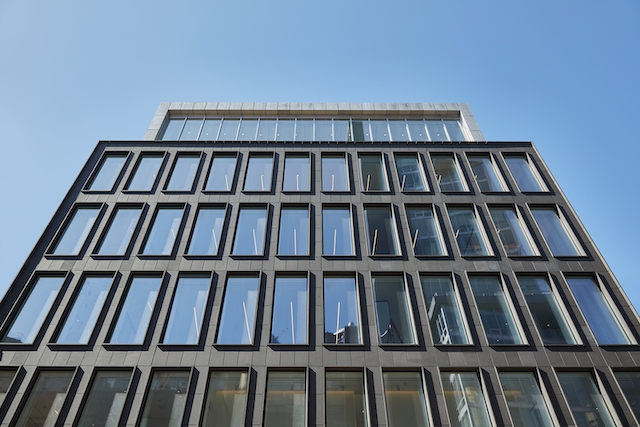While the bigger-is-better bulk of costly New York museums such as The Shed and the newly refurbished MOMA has grown up around them, leviathanlike commercial galleries Gagosian, Hauser & Wirth and David Zwirner have themselves spent the better part of the last decade building their own monuments to supersizing as the default mode of doing business. These expansions include but are not limited to adding artists to their respective stables, developing curatorial teams, inventing publishing arms (full disclosure: I recently published a volume with David Zwirner Books) and, of course, erecting ever-larger citadels in Manhattan and elsewhere (Paris, Hong Kong, Seoul, Menorca, Palo Alto, among others). Then, last September, Pace momentarily eclipsed its rivals by unveiling the Optimus Prime of commercial art spaces: a 7,000sqm, eight-storey behemoth in New York.
Located on West 25th Street, Pace Gallery’s new global HQ features a glittering veneer made of volcanic ash and aluminium, galleries that can house several major exhibitions simultaneously, private viewing rooms, office space for sibling outfits Pace/MacGill and Pace African & Oceanic Art, a 10,000-volume research library open to the public by appointment, a zone that seats 150 and serves the gallery’s new performance initiative, Pace Live, and a garden (with killer views of the Hudson River) capable of supporting 360 tons of art, a dedicated food truck and the cumulative weight of millions of artworld selfies. Not only does Pace’s new building boast more square meterage than the planned addition to the New Museum, it’s also bigger than the Met Breuer.
Unsurprisingly, Pace HQ’s price tag is similarly impressive. The building cost a reported $80 million, plus an additional $18.2m to build out the polished concrete, stainless steel and whiteoak interior. Incredibly, Pace does not own the building. Instead, it is leasing the premises from Weinberg Properties for a figure estimated by Artnet News to be $704,000 a month (that’s $8.45m annually and $220m over the life of the 20-year lease, accounting for rent increases). Did I mention the property is built on a flood zone?
Like other head-scratching corporate gambles (Northrop Grumman’s $2 billion-per-copy Stealth Bomber comes to mind), the dollars-and-cents logic of this financial legerdemain outstrips the cheque-balancing of mere mortals. To mogulsplain, Pace Gallery president and CEO Marc Glimcher and new curator Mark Beasley (the latter joining from the Hirshhorn Museum) have invoked an enter-through-the-giftshop rationale to partially describe their expandedbusiness logic: it’s about tapping into other commercial models, they say, including the experience economy, retail, Silicon Valley management and, yes, the real-estate industry’s obsession with, ahem, inseam measurements. At least one art writer validates these voodoo economics: Artnet News’s Brook Mason reports that at approximately $20 per person, the entry fee paid by the 500,000 visitors to the gallery’s exhibitions of Tokyo-based collective teamLab at Pace’s Palo Alto, London and Beijing locations would have brought in upwards of $10m. But is Pace really looking to reinvent the traditional saleable-object gallery model? And if they are, will its competitors follow?
Whatever the answers – ie, the actual and projected payoff at the till – Pace’s supersizing is just the latest salvo in an arms race of epic expenditure among the gallery’s rivals, with – surprise! –¯a new round of expansions visible across Chelsea. The district’s wealthiest dealers are ramping up in scale and plunking down eye-watering sums for newly designed quarters. Hauser & Wirth announced it is adding a new Annabelle Selldorf-designed building at 542 West 22nd Street to its property portfolio; Larry Gagosian has moved into the former quarters of Mary Boone and Pace, adjacent to his 2,500sqm gallery (his empire already totals 16,000sqm globally); and David Zwirner is set to break ground on a new fivestorey, $50m flagship at 540 West 21st Street, designed by Pritzker Prize-winner Renzo Piano. Unlike GAFA – Google, Amazon, Facebook, Apple – art’s new world order remains, for the moment, a confusing consonant salad: PDZGHW.
Where will these gargantuan expansions lead? Like the gameshow said, that’s anybody’s guess, but one may safely assume they will result in additional Transformer-like synergies that hint at fantastical futures while running through piles of speculative cash. With New York-based megagalleries today, it’s all about keeping pace.
Christian Viveros-Fauné is a writer and curator based in New York
From the March 2020 issue of ArtReview
